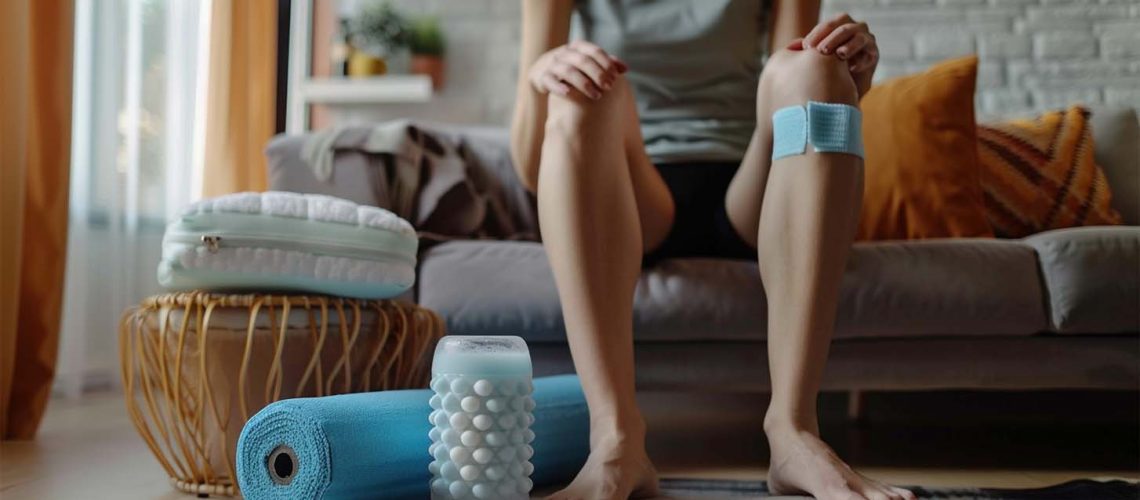When dealing with knee pain at home, it’s essential to first identify potential causes like overuse, sudden movements, improper footwear, even driving your car can cause knee pain. Rest your knees and apply ice for 15-20 minutes every 2-3 hours to reduce inflammation. Engage in gentle at-home exercises such as leg raises and stretching to strengthen knee muscles and improve mobility. Utilize heat therapy by applying a warm towel or reusable heat pack for 15-20 minutes at a time to increase blood flow.
Incorporating foods rich in Omega-3, Vitamin C, Calcium, Vitamin D, and antioxidants can help reduce joint inflammation and promote overall joint health. For further insights into natural remedies and lifestyle adjustments for long-term relief, explore additional information available.
Key Takeaways
- Rest and avoid activities that strain the knees.
- Apply ice pack for 15-20 mins every 2-3 hours.
- Engage in gentle stretching exercises like leg raises.
- Use heat therapy with a warm towel for relief.
- Consume nutrients like Omega-3, Vitamin C, and calcium for joint health.
Understanding Knee Pain Causes
To understand knee pain causes, examine your daily activities and any recent injuries that may have contributed to the discomfort. Knee pain can be a result of various factors such as overuse, muscle imbalances, or sudden movements that strain the knee joint. High-impact activities like running or jumping without proper warm-up can also lead to knee pain. Additionally, improper footwear or sudden changes in physical activity levels can put added stress on your knees.
Furthermore, excess body weight can contribute to knee pain as it places extra pressure on the knee joint during movement. Poor posture and incorrect body mechanics while exercising or performing daily tasks can also lead to knee discomfort. It’s essential to pay attention to these potential causes to better understand and address your knee pain effectively. By identifying the root of the issue, you can take appropriate steps to alleviate the pain and prevent further complications.
Importance of Rest and Ice
Rest and ice are crucial components in managing knee pain effectively. When you experience knee pain, it’s essential to give your knee proper rest to allow the injured tissues to heal. Avoid activities that put strain on your knees, such as running or jumping. Instead, opt for gentle movements or complete rest to prevent further damage.
Icing your knee can help reduce pain and inflammation. Apply an ice pack to the affected area for about 15-20 minutes every 2-3 hours during the first 48 hours after the injury. Make sure to wrap the ice pack in a towel to protect your skin from ice burn. The cold temperature helps constrict blood vessels, decreasing swelling and numbing the area to alleviate pain.
Effective Home Exercises for Relief
Engage in gentle stretching exercises to help alleviate knee pain and improve flexibility at home.
Start with a quad stretch by standing on one leg and bending your other knee, bringing your foot towards your buttocks and holding for 30 seconds. Repeat on the other leg.
Next, try hamstring stretches by sitting on the floor with one leg extended and the other bent, reaching towards your toes while keeping your back straight. Hold for 30 seconds and switch legs.
You can also do calf stretches by standing facing a wall, placing your hands on it, and stepping one leg back while keeping it straight, pressing the heel down. Hold for 30 seconds and switch legs.
Additionally, try leg raises while lying on your back, lifting one leg at a time to strengthen the muscles around your knee. Perform each stretch 2-3 times daily to help reduce knee discomfort and enhance mobility.
Utilizing Heat Therapy at Home
Consider applying a heat pack or using a warm towel to help relieve knee pain and promote relaxation at home. Heat therapy can be beneficial in easing knee discomfort by increasing blood flow, relaxing muscles, and reducing stiffness.
To apply heat therapy, you can use a reusable heat pack that can be warmed up in the microwave or a hot water bottle wrapped in a towel. Place the heat pack on the affected knee for about 15-20 minutes at a time, making sure not to apply it directly to the skin to avoid burns.
Alternatively, you can soak a towel in warm water, wring out the excess water, and then place it on your knee. This method can also provide soothing relief. It’s essential to use heat therapy in moderation and avoid prolonged exposure to prevent skin irritation or other complications.
Remember to consult with a healthcare professional if you have any concerns or if the knee pain persists.
Benefits of Proper Nutrition
To complement your efforts in managing knee pain through heat therapy, understanding the benefits of proper nutrition can play a vital role in overall joint health and well-being. A balanced diet rich in essential nutrients can help reduce inflammation, support muscle and tissue repair, and maintain a healthy weight, which alleviates stress on your knees. Below is a table highlighting key nutrients that can benefit your knee health:
| Nutrient | Source | Benefits |
|---|---|---|
| Omega-3 fatty acids | Salmon, chia seeds | Reduce inflammation in the joints |
| Vitamin C | Citrus fruits, bell peppers | Promote collagen production for joint strength |
| Calcium | Dairy products, leafy greens | Strengthen bones and support joint structure |
| Vitamin D | Fatty fish, fortified foods | Aid in calcium absorption for bone health |
| Antioxidants | Berries, spinach | Protect cells from damage and reduce inflammation |
Incorporating these nutrients into your daily meals can contribute to better knee health and potentially reduce pain and discomfort. Remember, a well-rounded diet is key to supporting your body in its healing process.
Natural Remedies to Soothe Pain
Implement simple yet effective natural remedies to alleviate knee pain and promote comfort and mobility. Here are some natural remedies that can help soothe knee pain:
- Warm Compress: Applying a warm compress to your knee can help reduce pain and stiffness by increasing blood flow to the area.
- Gentle Massage: Massaging the muscles around your knee with gentle pressure can help relax tight muscles and alleviate pain.
- Epsom Salt Soak: Soaking your knee in warm water mixed with Epsom salt can help reduce inflammation and ease discomfort.
- Turmeric Tea: Drinking turmeric tea or adding turmeric to your meals can help reduce inflammation in the body, potentially easing knee pain.
These natural remedies can be easily incorporated into your daily routine to provide relief from knee pain. Remember to consult with a healthcare professional if the pain persists or worsens.
Using Compression and Elevation
To further alleviate knee pain at home, you can enhance your treatment by utilizing compression and elevation techniques. Compression helps reduce swelling and provides support to the knee joint, while elevation helps to decrease inflammation and improve blood flow. Here’s how you can effectively apply these methods:
| Compression | Elevation | Instructions | Frequency |
|---|---|---|---|
| Use a knee brace or bandage | Elevate your leg above heart level | Wrap the knee snugly, not too tight | 3-4 times a day |
| Apply cold compress | Use a pillow to support the leg | Leave the wrap on for 15-20 minutes | After every session |
| Avoid standing for long periods | Rest your leg on a chair or cushion | Re-adjust the wrap if it feels too tight | Before bedtime |
Lifestyle Changes for Long-Term Relief
Consider making lasting changes to your daily habits to achieve long-term relief from knee pain. Incorporating these lifestyle adjustments can help you manage your knee pain more effectively over time:
- Maintain a Healthy Weight: Excess weight puts added stress on your knees. By maintaining a healthy weight through a balanced diet and regular exercise, you can reduce the strain on your knee joints.
- Stay Active with Low-Impact Exercises: Engage in activities like swimming, cycling, or yoga to keep your joints moving without causing further damage to your knees.
- Ensure Proper Footwear: Wearing supportive shoes that provide cushioning and stability can help alleviate pressure on your knees during daily activities.
- Practice Good Posture: Maintaining proper posture while sitting, standing, and walking can help distribute weight evenly and reduce strain on your knees.
Frequently Asked Questions
How Can Mental Health and Stress Levels Impact Knee Pain?
When stress levels are high, it can affect your mental health and physical well-being, potentially exacerbating knee pain. It’s important to manage stress through relaxation techniques and seeking support to alleviate its impact on your knees.
Are There Any Specific Vitamins or Supplements That Can Help With Knee Pain Relief?
You can consider taking vitamins and supplements like glucosamine, chondroitin, and omega-3 fatty acids to help with knee pain relief. Always consult with a healthcare provider before starting any new supplements to ensure safety and effectiveness.
Can Poor Posture or Improper Footwear Contribute to Knee Pain?
Yes, poor posture and improper footwear can indeed contribute to knee pain. Maintaining good posture and wearing supportive shoes can help alleviate strain on your knees, reducing the likelihood of experiencing discomfort or injury.
What Role Does Hydration Play in Managing Knee Pain?
Staying hydrated is crucial in managing knee pain. Water helps maintain cartilage health and lubricates joints. Dehydration can worsen inflammation and discomfort. Aim to drink plenty of water daily to support your overall joint health.
Is It Common for Knee Pain to Be Related to Underlying Health Conditions Such as Arthritis or Fibromyalgia?
Yes, it’s common for knee pain to be related to underlying health conditions like arthritis or fibromyalgiaCondition causing widespread soft tissue/muscle pain and tenderness to light touch attributed to oversensitized nerves.. These conditions can exacerbate discomfort in your knees. Consulting a healthcare provider for proper diagnosis and treatment is crucial.

